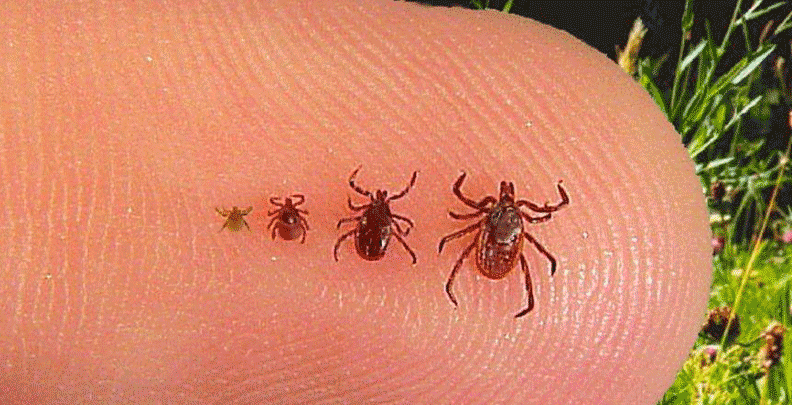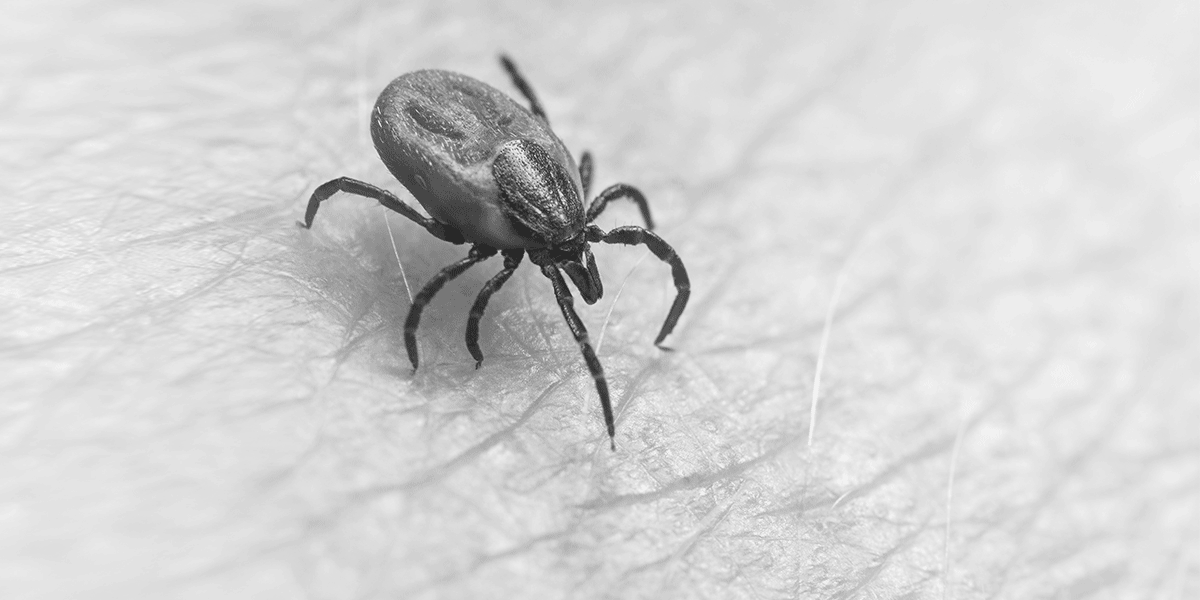
American Dog Tick (Dermacentor variabilis)
Commonly found: East of the Rocky Mountains and in some areas on the Pacific Coast.
Diseases transmitted: This tick can transmit Rocky Mountain Spotted fever, Tularemia, and ehrlichiosis to humans.
Characteristics: The American dog tick, also known as the eastern wood tick, is most active during the spring and summer. Adult females are the most likely to bite humans and dogs. This tick has cream/gray markings on its back and near its mouth and the males often have silvers lines along its back. It does not transmit Lyme disease.
Eastern Blacklegged Tick (Ixodes scapularis)
Commonly found: Across the east coast, the upper midwest, and the Great Lakes region.
Diseases transmitted: They can transmit Lyme disease, Powassan disease, and babesiosis. The Blacklegged tick needs to be attached to a human for at least 24-48 hours to transmit Lyme disease.
Characteristics: This tick, also known as the deer tick, is one of the most common ticks in the United States and one of the most common spreaders of Lyme disease. They are the smallest tick in North America and have a distinctive red body with a black shield on their back. They’re often found near trails in wooded areas. Deer ticks are most active from the spring to the fall months and feed on domestic animals, wildlife, and humans.
Brown Dog Tick (Rhipicephalus sanguineus)
Commonly found: They are found across the United States but have a large concentration in the southern states. They are actively feeding throughout the year. They can be found outdoors, but are also found indoors after being carried indoors on the dog they’re feeding on.
Diseases transmitted: This tick can transmit Rocky Mountain Spotted Fever, Q Fever, and other forms of rickettsioses to both humans and dogs.
Characteristics: Also known as the kennel tick, has a reddish-brown color and an elongated body. They commonly feed on dogs, but they also sometimes feed on humans. This tick is unique from others on the list because its life cycle allows it to survive indoors.
Gulf Coast Tick (Amblyomma maculatum)
Commonly found: In the Gulf of Mexico, Southeastern and mid-Atlantic states, and parts of Southern Arizona.
Diseases transmitted: This tick transmits a form of spotted fever called R. parkeri rickettsiosis.
Characteristics: This tick varies in color from dark bluish grey to a dull white. The females are typically dark gray with white near the head and three lateral stripes. The larvae and nymph Gulf Coast ticks feed primarily on small rodents and birds. Adult female Gulf Coast ticks feed on deer, humans, and other large forms of wildlife.
Lone Star Tick (Amblyomma americanum)
Commonly found: The Lone Star tick is most common in the South, but can also be found throughout the Eastern states. They like to burrow in dense undergrowth and in the woods.
Diseases transmitted: Nymphal and adult Lone Star ticks can transmit Rocky Mountain Spotted Fever, Q fever Monocytic Ehrichiosis, tick paralysis, Heartland virus, Bourbon virus, Tularemia, and STARI. It is not believed to transmit the bacteria that causes Lyme disease.
Characteristics: You can identify this tick by its reddish-brown color and a white dot, or “lone star”, on its back. Only adult females have a white dot. People who have been bitten by this tick often develop a delayed allergic reaction to eating red meat (a condition known as “alpha-gal allergy”). These ticks are known to be aggressive biters and are most active from early Spring to Late fall.
Rocky Mountain Wood Tick (Dermacentor andersoni)
Commonly found: This tick is found around the Rocky Mountain states (Idaho, Montana, Wyoming, Colorado, Utah, and New Mexico). They tend to live in elevations above 4,000 feet near trails and prefer open grasslands and lightly wooded areas.
Diseases transmitted: They can transmit pathogens for the Colorado tick fever virus (CTFV), Rocky Mountain spotted fever, Tularemia, and Q fever. If you or your pet get bitten by this tick, the neurotoxin in the tick’s saliva may cause tick paralysis. It usually takes 1-3 days for the neurotoxin to dissipate.
Characteristics: This tick looks similar to American dog ticks with a reddish-brown coloring and a cream-colored shield near their head. They’re most active from January to November and become less active during the summer months. Rocky Mountain Wood ticks can survive without feeding for up to 600 days.
Western Black Legged Tick (Ixodes pacificus)
Commonly found: This tick is found in states along the Pacific Coast, mostly concentrated in northern California. It has also been found in Oregon, Washington, Nevada, Arizona, and Utah. They prefer to live in dense woods among the fallen leaves and branches.
Diseases transmitted: Adult Western Black Legged Ticks can transmit Anaplasmosis, human granulocytic anaplasmosis (HGA), Lyme disease, and Borrelia miyamotoi disease, a form of relapsing fever.
Characteristics: You can identify this tick by its red body, black shield, and black legs. Since this tick often feeds on small animals such as lizards, the human infection rate is low (around one percent). Nymphs and adult females are most likely to bite humans.
Soft Tick (Ornithodoros)
Commonly found: Throughout the western states, including Texas. They live in coniferous forests at elevations between 900 and 2000 meters above sea level.
Diseases transmitted: Soft ticks can transmit two strains of Tick-borne Relapsing Fever (TBRF): Borrelia hermsii and Borrelia turicatae. They prefer to feed on birds and bats, but can still infect humans. Since their bite is often painless, most victims don’t realize they have been bitten.
Characteristics: As its name suggests, this tick does not have a hard shell-like the other ticks on the list. They have less visible legs and look similar to a raisin. Documented infections in Texas have been associated with cave exploration. They prefer to feed at night and are often found on humans after sleeping.
Groundhog Tick (Ixodes cookei)
Commonly found: This tick can be found across the eastern half of the United States.
Diseases transmitted: This tick primarily transmits the Powassan virus.
Characteristics: Also known as the Woodchuck tick, the Groundhog tick has a light brown/blonde shell and legs. It gets its names from the types of animals it feeds on: small warm-blooded animals like groundhogs, woodchucks, squirrels, raccoons, and occasionally humans.

